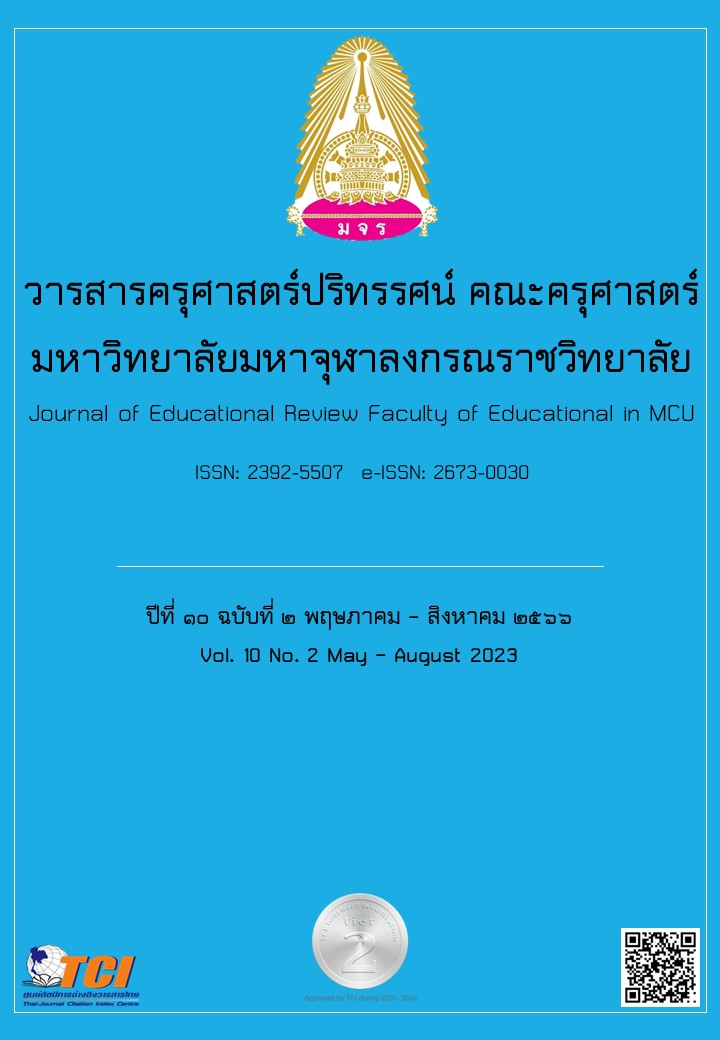SUPAT MODEL: A LEARNING MODEL TOWARDS INNOVATION DEVELOPMENT OF LEARNERS IN CONJUNCTION WITH THE FOUR IDDHIPADA IN THE 21ST CENTURY
Main Article Content
Abstract
This academic article discusses a learning model towards innovation development for learners by integrating the four principles of Iddhipada. The primary objective of this model is to enable the learners to develop and invent their own innovations, in line with the necessary skills required in the 21st century. These skills include 1) learning and innovation skills, 2) information, media, and technology skills, and 3) life and career skills. To achieve the goal of enhancing learners' skills in the 21st century, the researcher has developed a learning model towards innovation development called the SUPAT Model, which consists of five steps: 1) searching for information, which is a process of obtaining knowledge and information, 2) understanding, which is a way to understand and conceptualize contents 3) planning and practice the design of innovation, 4) applying the innovation, and 5) transferring the innovation to the public, including the community and society. Furthermore, by adopting the learning model towards innovation development, the SUPAT Model must be integrated with the Four Iddhipada, which include 1) Chanda, the determination and love of learning, 2) Virya, effort in learning, 3) Citta, thoughtfulness in learning with no negligence, and 4) Vimamsa, investigation and self-examination in learning. The learning model towards innovation development for learners must be applied in conjunction with the integration of the Four Iddhipada in the learning processes in order to develop learners' full potential in innovation.
Article Details

This work is licensed under a Creative Commons Attribution-NonCommercial-NoDerivatives 4.0 International License.
ทัศนะและความคิดเห็นที่ปรากฏในบทความในวารสารฉบับนี้ถือเป็นความรับผิดชอบของผู้เขียนบทความนั้นเพียงผู้เดียว และไม่ถือเป็นทัศนะและความรับผิดชอบของกองบรรณาธิการ
กองบรรณาธิการขอสงวนสิทธิ์ในการคัดเลือกบทความลงตีพิมพ์และจะแจ้งให้เจ้าของบทความทราบหลังจากผู้ประเมินบทความตรวจอ่านบทความแล้ว
ต้นฉบับที่ได้รับการตีพิมพ์ในวารสารครุศาสตร์ปริทรรศน์ คณะครุศาสตร์ มหาวิทยาลัยมหาจุฬาลงกรณราชวิทยาลัย ถือเป็นกรรมสิทธิ์ของคณะครุศาสตร์ มหาวิทยาลัยมหาจุฬาลงกรณราชวิทยาลัย ห้ามนำข้อความทั้งหมดหรือบางส่วนไปพิมพ์ซ้ำ เว้นเสียแต่ว่าจะได้รับอนุญาตจากมหาวิทยาลัยฯ เป็นลายลักษณ์อักษร
References
ทิศนา แขมมณี. (2553). ศาสตร์การสอน: องค์ความรู้เพื่อการจัดกระบวนการเรียนรู้ที่มีประสิทธิภาพ. พิมพ์ครั้งที่ 13. กรุงเทพมหานคร: จุฬาลงกรณ์มหาวิทยาลัย.
พระธรรมโกศาจารย์ (ปัญญานันทภิกขุ). (2545). พจนานุกรมธรรมของท่านปัญญานันทะ. กรุงเทพมหานคร: ธรรมสภา.
พระธรรมปิฎก (ป. อ. ปยุตโต). (2543). ทศวรรษธรรมทัศน์พระธรรมปิฎก หมวดศึกษาศาสตร์. กรุงเทพมหานคร: ธรรมสภา.
พระธรรมปิฎก (ป. อ. ปยุตฺโต). (2543). ธรรมะกับการทำงาน. พิมพ์ครั้งที่ 3. กรุงเทพมหานคร: มูลนิธิพุทธธรรม.
พระธรรมปิฎก (ประยุทธ์ ปยุตฺโต). (2546). พจนานุกรมพุทธศาสตร์ ฉบับประมวลธรรม. กรุงเทพมหานคร: สหธรรมิก.
พระพรหมคุณาภรณ์ (ป. อ. ปยุตโต). (2549). พุทธธรรม ฉบับปรับปรุง และขยายความ. พิมพ์ครั้งที่ 11. กรุงเทพมหานคร: สหธรรมิก.
พระพรหมคุณาภรณ์ (ป. อ. ปยุตฺโต). (2545). ธรรมนูญชีวิต. พิมพ์ครั้งที่ 46. กรุงเทพมหานคร: กรมศาสนา.
พิมพันธ์เดชะคุปต์ และพเยาว์ ยินดีสุข. (2560). ทักษะ 7C ของครู 4.0. กรุงเทพมหานคร: โรงพิมพ์แห่งจุฬาลงกรณ์มหาวิทยาลัย.
พุทธทาสภิกขุ. (2549). การงานที่เป็นสุข. กรุงเทพมหานคร: ธรรมสภา.
ภัทรนันท์ ไวทยะสิน. (2562). “เปลี่ยน” ผู้เรียนเป็นนวัตกร นวัตกรรมใหม่ของการเรียนการสอนในยุคการศึกษา 4.0. วารสารเทคโนโลยีและสื่อสารการศึกษา ECT Journal. 17. 37-51.
มหาจุฬาลงกรณราชวิทยาลัย. (2539). พระไตรปิฎกภาษาไทย ฉบับมหาจุฬาลงกรณราชวิทยาลัย. กรุงเทพมหานคร: มหาจุฬาลงกรณราชวิทยาลัย.
วิโรจน์ สารรัตนะ. (2556). กระบวนทัศน์ใหม่ทางการศึกษา กรณีทัศนะต่อการศึกษาศตวรรษที่ 21. กรุงเทพมหานคร: ทิพยวิสุทธิ์.
สมบูรณ์ สงวนญาติ.(2534). เทคโนโลยีทางการเรียนการสอน. กรุงเทพมหานคร: กระทรวงศึกษาธิการ.
สำนักงานเลขาธิการสภาการศึกษา. (2562). มาตรฐานการศึกษาของชาติ พ.ศ. 2561. กรุงเทพมหานคร: 21 เซ็นจูรี่.
Kay, K. & Greenhill, V. (2011). Twenty-first century students need 21st century skills. In Wan, G (Ed), Binging schools into the 21st century. New York: Springer Dordrecht Heidelberg.
OECD. (2018). The Future of Education and Skills Education 2030. Paris: Organization for Economic Co-operation and Development.
Pearson cooperation. (2017). The Future of Learning: Pearson Annual Report and Accounts 2017. New York, NY: Pearson.


